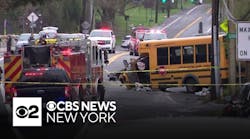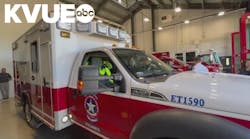Aug. 25--DUNCAN -- The day Lane was shot, the fire vehicles had to roll through six red lights in about 2.6 miles between the Fire Department and the scene, Duncan Police Sgt. Patrick Norton said.
On Friday, one week to the day of the shooting, Norton drove the route from the Duncan Fire Department to the scene where Christopher Lane was found shot Aug. 16. He made it in 5 minutes and 15 seconds.
Norton, an officer with the Duncan Police Department, was obeying the rules of the road. On his way back, it took him closer to 6 minutes to make it back because he had to pull over for incoming emergency vehicles, which first got stuck behind a cable truck and then a car, neither of which immediately yielded to the emergency vehicle.
Norton said there are various elements involved in each call that can impact how quickly emergency vehicles can respond to a call. The same could be said about the dispatchers at the Duncan Police Department, Norton said.
"People think we answer phones and get on the radio occasionally," Norton said. "That call (pertaining to Lane) reflects that we are not just operators. Ninety percent of the time, everything happens all at once."
At the time of the 911 call placed by Joyce Smith that Friday, the City of Duncan's dispatch service had two dispatchers working. Incoming calls on any given day range from medical to fires to crimes to non-emergency situations. The dispatchers also have to dispatch units for the appropriate calls, and play a role in determining what gear firefighters wear to a scene.
Norton said a team effort made things go smoothly when the call regarding Lane came in. Emergency vehicles were dispatched quickly.
"This particular day, the dispatchers were working well together," he said. "One dispatcher was online with the caller, and the other dispatcher was calling out to the Fire Department, to AMR (American Medical Response), to the Police Department. We were able to get people out there more quickly."
City Manager Jim Frieda said he has concerns about how the Duncan dispatch service is being perceived as it dealt with the call. Frieda said he had seen something in a newspaper indicating that "we didn't respond well."
Frieda said the call was answered at 2:57 p.m., the call was dispatched at 2:59 and the first officer arrived at the scene at 3:03 p.m.
Duncan fire engine No. 1 arrived at 3:06 p.m. and on board were two emergency medical technicians with the necessary medical equipment to assist in sustaining life.
Frieda said he heard in the call where the woman said she did not hear any sirens yet, and the dispatcher assured her there was a dispatch and emergency personnel on the way.
"There is nothing to indicate to me that the dispatcher on 911 handled it incorrectly," Frieda said.
Norton said calls can take up to two minutes to determine a location, especially if the call is made on a cell phone because the call has to bounce off a tower. While the call may have taken 6 minutes to get someone to the scene, Norton said responders had two minutes less than that to get ready and get to the scene. He said police officers were on the scene in four minutes after being dispatched.
When the call came in about Lane being shot, the caller referred to her location as being Plato and Twilight Beach, Norton said, which he knew couldn't be right because the two streets run parallel.
He said he recognized the location as being on Country Club near Twilight Beach, but had the dispatcher confirm the location with the caller.
The dispatcher remained on the line to get more information. Norton said this is important to determine what's happening on the scene, and if there are any issues that could cause harm to people responding to the call.
"We can't afford for an ambulance to roll up on an active shooter," Norton said. "We can't afford for the fire truck to roll up on an active shooter."
Fire vehicles have to obey many of the rules of the road, he said, including not passing on the right. The vehicles also can't exceed 50 to 60 miles per hour, based on what equipment is on board and which vehicle is being used, because of federal guidelines.
"When a dispatcher said she can't get them to go any quicker than they are, she's not just saying that," Norton said.
On an average day, the dispatch services receives upwards of 300 calls. On the primary line, the services fields 200 to 300 calls in a 24-hour period. If the main line already has a call on it, the next call rolls to a second line. If the second line also has a call on it, the call goes to the third line.
Norton said most days, there are only two dispatchers on duty.
The call volume at 2:30 p.m. Friday included 273 on Line 1, 66 on Line 2 and 40 on Line 4. For that entire day, which is a 24-hour period, dispatchers also had 680 calls to police units, 63 calls to fire units and 85 calls to 911. Norton said these numbers are consistent with what the dispatchers get on a typical day.
"People don't really know what it takes to get people help," Norton said. "It's a hard job. They (the dispatchers) don't get thanked like they should."
Reporter Mike Smith contributed to this story.
Copyright 2013 - The Duncan Banner, Okla.





